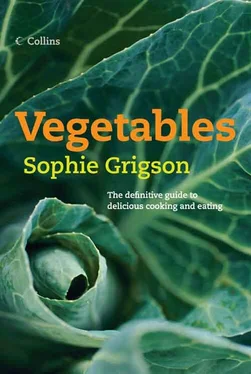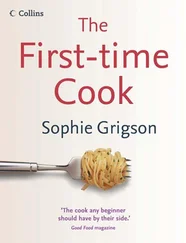85g (3oz) stoned dried dates
1 teaspoon ground cumin
1 teaspoon ground coriander
1/2teaspoon salt
Put the tamarind pulp, if using, in a bowl and pour over 150ml (5 floz) boiling water. Let it sit and soften for about 20 minutes, then stir and break up. Rub through a sieve and discard pips and fibres.
Put the dates into a saucepan with 300ml (10floz) water and simmer for 10 minutes or until very soft. Sieve the dates and their water to make a thick purée.
Mix with the cumin, coriander, tamarind purée and salt and stir in enough water to make a thick sweet and sour sauce. Taste and adjust seasoning.
Oven-baked potato skins with soured cream, garlic and chive/coriander dip
I like to eat the skin of my baked potatoes, but many people just scoop out the inside. Don’t let the skins go to waste, particularly if they still have a little potato flesh clinging to them. Coated lightly in oil and baked in a hot oven they crisp up to make a treat of a snack. Restaurants charge a hefty price for the privilege of eating fried potato skins and dips, but at home you can make something just as good for next to nothing.
Serves 2
roughly 200g (7 oz) leftover potato skins
2 tablespoons sunflower oil
salt
Dip
100 ml (31/2 floz) soured cream
2 tablespoons finely chopped chives or coriander
1 clove garlic, crushed
salt
Preheat the oven to 220°C/425°F/Gas 7.
Cut the potato skins into wide strips or long tapering triangles. Toss with the oil, making sure that they are evenly coated. Spread out on a baking sheet and bake for 10–15 minutes, turning once, until crisp. Check them regularly as they lurch from perfectly done to burnt all too swiftly.
Meanwhile mix all the dip ingredients together. Scrape into a bowl and place on the table. Serve the hot, crisp potato skins as soon as they come out of the oven, with the soured cream dip.
Cypriot potatoes with red wine and coriander
‘Patates spastes’ is a rather remarkable way of cooking potatoes – and extraordinarily delicious. First the potatoes are cracked open, then deep-fried and then, finally, finished with fragrant coriander seeds and red wine. The result is so good that they are worth cooking and eating just for a snack, though of course they are excellent with any red meat dish.
Serves 4
750g (1 lb 10oz) small new potatoes, scrubbed
sunflower or vegetable oil for deep-frying
1 tablespoon extra virgin olive oil
1 heaped tablespoon coriander seeds, coarsely crushed
130ml (41/2 floz) red wine
salt and pepper
Bash each potato with a wooden mallet or the end of a rolling pin, to crack open. Take it easy at first until you get the impact just heavy enough to do the job, without smashing each one to smithereens.
Heat a 4–5 cm (1 1/ 2in) depth of sunflower or vegetable oil in a saucepan, over a moderate heat. It’s hot enough when a cube of bread dropped into it fizzles gently and browns within 1 minute. Wipe the potatoes dry, then deep-fry in batches until golden brown, about 4 minutes. Drain on kitchen paper.
Now get a clean saucepan, and add the olive oil. Set over a low heat and when the oil is warm add the potatoes, coriander, salt and pepper, then at arms’ length, pour over the wine. Stir so that everything is nicely mixed, then cover tightly and leave to cook gently for another 17–20 minutes until the potatoes are tender and the wine has all been absorbed. Shake the pan once in a while, to prevent sticking, and turn the potatoes after about 10 minutes so that they each get a chance to sit in the wine.
Eat the wine-soaked potatoes while still hot and fragrant.
There are two ways to look at radishes. The first is as one of life’s more pleasing incidentals, a healthy pre-meal nibble that goes on the table alongside a bowl of olives or crisps or tortilla chips or whatever it is that you present when friends come round to eat. The other is as proper vegetables. Both are valid.
Crisp, peppery little summer radishesare indeed the perfect way to kick-start a meal, bold enough to set the gastric juices flowing, yet barely denting the appetite. They look handsome too, like miniature pink torpedoes, tipped in some instances with a flash of white. These small radishes are just the tip of the iceberg, however. Winter radishesare massive in comparison, and fiery in flavour. Look out for them in markets and farm shops – usually black-skinned and dusty with soil, chunky of girth, tapering to a point, like a shadowy parsnip or carrot. They can be eaten raw, but are not for the faint-hearted. Cooking subdues the peppery power, turning them into a pleasant, juicy vegetable, with a taste reminiscent of turnip minus the brassica tang of sulphur.
Then there are the oriental radishes, typified by the incredibly lengthy, white-skinned moolior daikon. If you have a yen for Japanese food, then this is the vegetable that is shredded into long crisp threads and piled alongside sushi and sashimi. It is believed to aid digestion, and is used widely throughout Japan. Though you are unlikely to find them in shops, other members of this group can be extraordinarily beautiful. They may not look anything special, but this is a beauty that is more than skin-deep. Cut them in half and you will reveal flashes and circles of stunning pink and purple in many different designs. Usually mild enough to use in salads, these are the radish supermodels. Like human supermodels they are rare and need to be nurtured and supported selflessly. In other words, you will probably have to grow your own, if you want a chance to discover the ultimate potential of the humble radish.
Flabbiness is as big a no-no for a radish as it is for a supermodel. Career
ended just like that, new model steps in. The whole raison d’être for a radish is crispness and freshness and vitality. The peppery spice is the added bonus, and that too is spoiled by flabbiness, swiftly developing a nasty sulphurous undertow (radishes are related to cabbages and mustards). One good reason to buy small radishes in bunches is that the leaves give you an instant freshness reading. Do they look lively and bright? Or are they wilting and curling in on themselves? If the latter is the case, they are already past their zenith, heading down the road to flabby doldrums and perhaps there already. The big winter and oriental radishes are rarely sold with leaves, and have a far longer shelf life. They should still be firm, however, without signs of flab or bruising.
Use up small radishes within a day or two of buying. To prepare, cut off the leaf (which can be cooked and eaten like spinach) and scrape away the papery flakes of skin around the stalk end. Rinse well and pop into a bowl of cold water. Keep in the fridge until ready to eat, then drain, dry and put out on the table. In France, they are accompanied by a pat of unsalted butter, and a little pot of coarse salt. Smeared with a dab of butter and dipped in salt they are extra good. Alternatively, mix crumbled flaky sea salt with crushed cumin and coriander and dip radishes into the mix to add extra savour.
Small radishes also have a place in the salad bowl. Halve them or slice them, before scattering over fresh summer salads of all sorts. They are particularly good in a potato salad, instead of finely chopped onion, where they add a hint of fire and colour. To cook as a vegetable, either sauté or stir-fry, or braise whole in barely enough water or stock to cover, adding a knob of butter.
Читать дальше












